DEPARTMENT OF HEALTH AND HUMAN SERVICES
NATIONAL INSTITUTES OF HEALTH
Statement by
Richard J. Hodes, M.D.
Director, National Institute on Aging
Fiscal Year 2003 Budget Request
Witness appearing before the
House Subcommittee on Labor-HHS-Education Appropriations
March 13, 2002
Director's Statement
Americans Are Living Longer and Healthier Lives
Conquering Alzheimer's Disease
Understanding the Biology of Aging
Reducing Disease and Disability
Conclusion
Director's Statement
Mr. Chairman and Members of the Committee:
I am pleased to present the President’s budget request for the National Institute on Aging (NIA) for FY 2003, a sum of $971,709,000, which reflects an increase of $75,645,000 over the comparable Fiscal Year 2002 appropriation. The NIH budget request includes the performance information required by the Government Performance and Results Act (GPRA) of 1993. Prominent in the performance data is NIH’s second annual performance report, which compared our FY 2001 results to the goals in our FY 2001 performance plan.
Americans over age 65 are more likely today than at any other time in history to be vigorous and productive. Life expectancy, disability rates, and health and wealth indicators have all shown significant improvement over the past decade. At the same time, healthy, comfortable older age continues to elude many Americans, particularly members of certain racial, ethnic, and socioeconomic groups. Diseases of aging, including Alzheimer’s disease, cardiovascular disease, osteoporosis, cancer, diabetes, and arthritis, affect too many older men and women, seriously compromising the quality of their lives. And the challenges of dealing with a rapidly aging population will continue to grow: According to data from the U.S. Bureau of the Census, there are today approximately 35 million Americans age 65 and older. If current demographic trends hold, that number will double by the year 2030. NIA is committed to supporting high-quality research to address all aspects of aging, from conditions and diseases that primarily affect older people to physical, behavioral, and cellular characteristics of the aging process.
Census data indicates that life expectancy in the United States is approximately 76 years, up from about 49 a century ago. This increase is largely due to improvements in health care, nutrition, and overall standard of living for most people. Longevity, particularly “super-longevity” (living 100 years or beyond), also has a significant genetic and molecular component. For example, several genetic polymorphisms are known to confer extreme longevity in animal models, and studies suggest that similar polymorphisms may operate in humans. Scientists have also found that a positive outlook in early life may be associated with greater longevity. More research is needed to understand the connection between early emotional state and length of life.
Not only are Americans living longer, but we’re also remaining healthier into old age. The most recent National Long Term Care Survey (NLTCS), the latest of a series of surveys of the U.S. elderly population, continues to document a dramatic decline in the overall prevalence of physical disability among older Americans over the past two decades. While 26.2 percent of the elderly were assessed as disabled in 1982, this figure dropped to 19.7 percent in 1999. Of particular note is the sharp reduction in disability rates among African Americans during the 1990s, reversing trends from the 80s. Results from the NLTCS also show significant declines in severe cognitive impairment, with 900,000 fewer cases in 1999 than expected based on the 1982 rates—a decline in prevalence from 5.2 to 2.7 percent. (Chart #1) The finding that cognitive disability is declining is also supported by evidence from the Health and Retirement Study, which indicated that declines were especially large among those with less than a high school education and those ages 80 and older, groups in whom cognitive impairment is particularly prevalent.
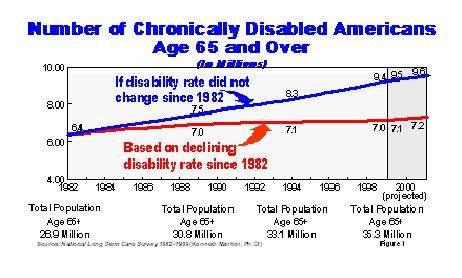
Alzheimer’s disease (AD), the most common cause of dementia among older persons, tragically affects as many as four million Americans, most of whom are 65 or older, according to the Alzheimer’s Association. However, we have made progress in several important areas. For example:
We are identifying risk factors. Identifying risk factors for AD will help us identify pathways affecting its development or progression and may lead to better predictors of the disease even before it is clinically apparent. Until last year, just four of the approximately 30,000 genes in the human genome were conclusively known to affect the development of AD pathology. Recent genetic studies suggest that as many as four additional and as yet unidentified genes may also be risk factors for late-onset AD. NIA-supported researchers are attempting to identify other risk factors through population studies.
We are improving our ability to diagnose AD early. Scientists are developing and refining powerful imaging techniques that target anatomical, molecular, and functional processes in the brain. These new techniques hold promise of earlier and more accurate diagnosis of AD, as well as improved identification of people who are at risk of developing the disease. Recent studies suggest that positron emission tomography (PET) scanning of metabolic changes in the brain and magnetic resonance imaging (MRI) scanning of structural brain changes may be useful tools for predicting future decline associated with AD and other neurodegenerative diseases.
We are developing new, more effective treatments for AD. One way to treat AD successfully may be to interfere with early pathological changes in the brain, including the development of AD’s characteristic amyloid deposits and neurofibrillary tangles. A number of promising approaches, many of them targeted at the reduction of amyloid plaques, are being developed and tested in various model systems. In 2001, NIA funded research to find new ways to treat AD by targeting underlying disease processes and continuing development of a vaccine to prevent the disease. Recent studies have successfully used antibodies to clear amyloid plaques from the brains of mice that were genetically engineered to develop AD-like pathology. Other recent studies have shown that statins, the most commonly used cholesterol-lowering drug, may reduce the risk of developing AD, and that high blood levels of the amino acid homocysteine may increase risk. (Chart #2) Increasing intake of folic acid and vitamins B6 and B12 can reduce blood levels of homocysteine, and NIA is planning a clinical trial of these substances to test whether supplementation can slow the rate of cognitive decline in people diagnosed with AD.
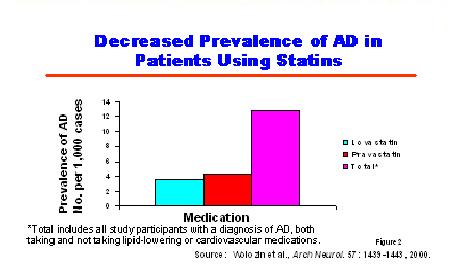
NIA is currently supporting 18 AD clinical trials, seven of which are large-scale prevention trials. (Chart #3) These trials are testing agents such as estrogen, anti-inflammatory drugs, and anti-oxidants for their effects on slowing progress of the disease, delaying AD’s onset, or preventing the disease altogether. Other intervention trials are assessing the effects of various compounds on the behavioral symptoms (agitation, aggression, and sleep disorders) of people with AD. The NIA is also supporting studies that are testing interventions for improving AD patient care delivery and alleviating caregiver burden.

We are continuing to advance our understanding of the molecular and cellular changes that underlie aging processes. New technologies are providing answers to questions about how genes control cell and tissue function. Arrays of DNA corresponding to specific genes permit the comparison of expression of tens of thousands of genes at one time to determine which are turned on or off in a particular cell or condition. A collection of 15,000 mouse genes has been developed, including genes active in early development. To facilitate extensive use of this gene collection, NIA has made it available to research institutions worldwide. Verified sequences of each gene in the set are also available; by comparing the sequence information with genes that have already been well studied, scientists may be able to determine the function of these genes in mice. The Institute has also developed the NIA Microarray Facility, which provides investigators with low-cost access to microarrays developed from the set and will also provide for collecting and analyzing the gene expression findings of multiple investigators.
Reducing Disease and Disability
In addition to AD, we have made a number of advances in other diseases and conditions. Our knowledge of the beneficial effects of exercise continues to increase; for example, last year researchers found that physical activity can stave off disability in older persons with osteoarthritis of the knee, a form of arthritis that is particularly common among people age 50 and over. (Chart #4) NIA’s highly successful campaign to encourage older people to exercise is working to translate research findings into action. Since the campaign was launched in 1998, NIA has distributed over 430,000 copies of its exercise guide and over 55,000 copies of its companion video to the public. In addition, a Spanish-language version of the guide was published in January 2002.
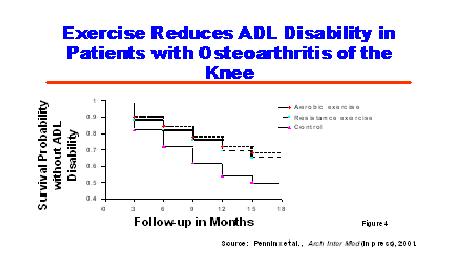
To address disability and disease in special populations, NIA implemented a major new study of health disparities among different racial, ethnic, and socioeconomic groups. The study, Healthy Aging in Nationally Diverse Longitudinal Samples (HANDLS), focuses primarily on cerebrovascular health, cardiovascular health, age-associated changes in cognition, and strength and physical functioning. Through this study, we hope to address hypotheses about aging and health disparities in minority and poor populations to understand the significance of environmental and genetic risk factors for disease. The pilot phase of HANDLS, in which investigators assessed the logistics and feasibility of this community-based study, was completed at the end of 2001, and the larger population-based phase of this study is scheduled to begin in late fall of 2002.
Other important research advances include:
Parkinson’s Disease. In an effort to develop a new model of Parkinson’s disease, scientists exposed rats to rotenone, a common pesticide. Exposed rats showed pathological changes characteristic of Parkinson’s disease, as well as motor behavior abnormalities, such as rigidity and decreased motor activity, that are frequently seen in Parkinson’s disease patients. This new model of Parkinson’s disease will be useful in designing and testing new therapeutic interventions, as well as further identifying environmental exposures that may be risk factors for developing the disease.
Diabetes. Diabetes is one of the major debilitating diseases that affect older people. Among the elderly, type 2 diabetes is the most common; it occurs when pancreatic beta cells produce insufficient insulin or when the body cannot use its insulin efficiently.
NIA-supported researchers participated in the Diabetes Prevention Program, a major, multi-institutional study that was initiated by the National Institute on Diabetes and Digestive and Kidney Diseases and was designed to identify interventions that could prevent or delay the development of type 2 diabetes. The researchers found that people who are at high risk for diabetes can sharply reduce their risk by adopting a low-fat diet and moderate exercise regimen. (Chart #5) This effect was most pronounced among study participants age 60 and over. Treatment with the drug metformin (Glucophage®) also reduced diabetes risk among study participants, but for unknown reasons was less effective among older participants. Nearly half of the study participants were members of racial and ethnic groups that suffer disproportionately from type 2 diabetes, including African Americans, Hispanic Americans, Asian Americans and Pacific Islanders, and American Indians.
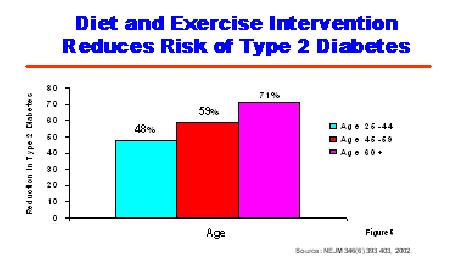
Cancer. Much remains unknown about cancer diagnosis, prevention, and treatment in older people. NIA supports a variety of cancer-related basic and clinical research projects, many of them in collaboration with the National Cancer Institute (NCI) and other NIH Institutes. For example, NIA has an initiative to expand knowledge on aging- and age-related aspects of prostate cancer in different populations. NIA and NCI have also created a partnership that has resulted in an aggressive research agenda within the NCI-designated cancer centers to reduce the burden of cancer for older persons.
Hip Fracture Recovery. According to a recent study (Marcantonio et al., J Am Geriatr Soc 48: 618-624, 2000), 250,000 older Americans fracture a hip each year, and delirium, an acute confusional state, complicates recovery from hip fracture repair in at least one-third of these people. Besides being frightening to patients and their families, and difficult to manage in the hospital, delirium after hip fracture is also associated with poor recovery of function in both the short and long term. In a recent study aimed at reducing risk factors for delirium, geriatricians provided a variety of recommendations to the orthopedic physicians caring for the hip-fracture patients. This intervention led to a one-third reduction in the number of patients who developed delirium and a one-half reduction in the patients who developed severe delirium.
Estrogen Replacement Therapy. Each year, millions of American women turn to hormone replacement therapy (HRT) to relieve peri- and post-menopausal symptoms and for protection against age-related conditions such as heart disease and osteoporosis. However, HRT can have unwanted side effects. In a recent clinical trial, women over age 65 received one of three doses of estrogen. The highest dose was the amount most commonly prescribed today, and the lowest dose was one-fourth of this amount. They found that the low dose markedly reduced bone breakdown, a reduction that was similar to that produced by the highest dose, and reduced the frequency of common side effects. In fact, low-dose therapy resulted in no more side effects than placebo. These findings suggest that a lower dose of estrogen may be just as effective as the regular dose, but have fewer side effects.
Cardiovascular Disease. An exciting area of stem cell research lies in the ability of the body to use its own stem cells to repair damaged organs. In a recent study, mice with induced heart damage were injected with particular proteins called cytokines. Stimulated by the cytokines, the mice’s own primitive bone marrow cells migrated to the heart, converted to several different types of cardiac cells, and contributed to repair of the damaged tissue, improving both heart function and survival of the treated mice. (Chart #6) In a study of human heart transplant patients, scientists found that primitive cells from heart transplant recipients can migrate to and become a functioning part of the donated heart. These results are extremely preliminary, and further research is needed. However, the findings from these studies challenge the conventional wisdom that damaged heart tissue cannot be regenerated, and suggest that the body’s own naturally occurring stem cells may be able to repair tissue damage and fight disease.
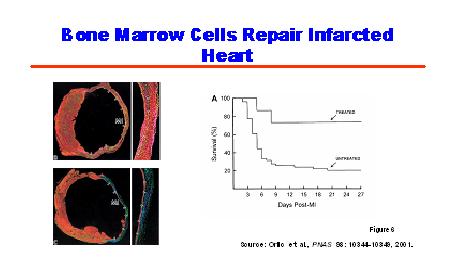
Conclusion
It is becoming increasingly obvious that old age need not be associated with illness, frailty, or disability. In fact, we have made tremendous progress against all of the major diseases and conditions of aging. However, much work remains to be done. By continuing and intensifying research, NIA can move forward in meeting the promise of extended life by improving the health and well-being of older people in America.
